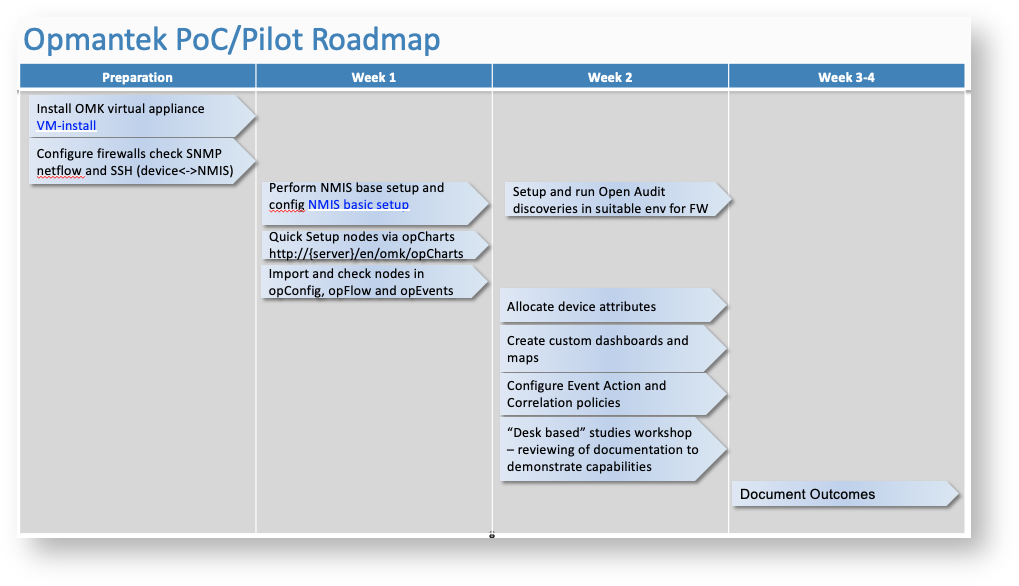If you're considering running a trial or proof of concept or Opmantek's Solutions, or just looking for more information, start here.
Links to Common Questions
Learning about Opmantek's products and capabilities - is a trial the best place to obtain information?
- Opmantek Website and Opmantek Community and Product Documentation
- Webinars and videos
- Presales presentations and live product demonstrations
- How to request large license packs for trials
- What manufacturers does Opmantek NMS support?
- Where can I find product pricing?
Identify Your Products and Solutions
- NMIS - Deep visibility of an IT environment, providing valuable information about infrastructure performance and faults.
- ICMP/Ping
- SNMP Collection
- SNMPTraps
- WMI Collection
- Service Monitoring (DNS/NTP/etc.)
- Application Monitoring
- opHA - Scale your solution horizontally and add high availability to ensure business continuity.
- Open-AudIT - Agentless device discovery and auditing
- Device Baselining
- File/Folder Change Monitoring
- Software License Usage
- opCharts - Delivers interactive charts, custom dashboards, and network diagrams.
- opEvents - Event Management processing Syslog, SNMP trap, NMIS events, and others.
- Syslog Parsing
- SNMPTraps
- opConfig - Provides configuration backup, archiving, and change detection.
- Configuration Backup
- Compliance Monitoring
- opTrend - Identify abnormal behavior and predict resource exhaustion before it happens.
- opReports - Detailed, actionable engineering and business-related reports
- opFlow/opFlowSP - NetFlow and IP-Fix analysis for enterprise-class businesses and service providers
Demo vs. Trial vs. PoC vs. Pilot. What are you running?
Trial
- Small scale, often adhoc
- Usually run by the customer to:
- Discover one or two documented features
- Familiarize themselves with the product line, and
- Demonstrate the solutions that are capable of managing devices which they use.
Proof of Concept (PoC)
- More defined than a trial, larger scale with a greater number of devices being tested and more in-depth feature review
- Includes a defined and agreed-up scope and timeline
- Opmantek engineering support to prove new features
- The goal of a PoC is to PROVE the solution meets the client's requirements and to remove any remaining doubt so that an agreement can be completed
Pilot
- Large scale, demonstrating full production capability under a commercial agreement.
- Includes a defined and agreed-up scope and timeline
- Opmantek engineering support to prove new features
- May include professional services for integration with 3rd party components, custom device modeling, and other services.
- The goal of a Pilot is to demonstrate the Opmantek solution(s) at scale, often in a production environment, as well as demonstrate Opmantek's ability to provide the identified customizations.
- A pilot has a defined outcome, e.g. selection approval/purchase order
- Due to the resources involved Opmantek typically charges for running a Pilot vs. a PoC.
What do we need to start?
Running a PoC or a Pilot cost money for both the customer and Opmantek - both parties should be sure of what they expect to gain and the probabilities.
- Scope of what is to be trialed (the trial checklist)
- What and how many devices
- Which products, features, and use cases to test
- An agreed plan of how we set up and operate the trial
- Staff commitments
- Timelines
- Support process during the trial
- What equipment and environments do we have access to?
Sample Documentation
When conducting a Trial you should start with a list of features or functionality that you feel are necessary in order to ensure the product(s) will meet your needs. Opmantek has prepared the following list as a starting point for you. However, you should decide for yourself what features are important to your organization.
Trial Outcome
You should identify and agree on the Trial Outcome, e.g. "To determine if the Opmantek solution is suitable for use in managing the core network, servers, and customer network infrastructure."
Timeline
How much time is needed in order to evaluate the product to the degree necessary? Are there sufficient resources available to meet this goal?
Technical Details
Devices to Manage in Trial
Provide a list by manufacturer and model of which devices will be included in the trial.
General Requirements
- Hardware, network, and security requirements
- Security; including authentication mechanism, roles and group administration
- Architecture options
- User interface requirements
- Usability and transition between performance, event, and configuration solutions
- Reporting
Network Discovery (Open-AudIT)
- Test discovery on a targeted subnet
- Configure to populate NMIS with discovered systems
Performance Management Requirements (NMIS)
- Polling policy; timings and collection policies
- Business policy functions
- KPI Adaptation
- Thresholding and statistics
- Thresholding controls
- Roles based alarm criticality
- NMIS Plugin and Notification system
Data Visualization (opCharts)
- Test creation of Maps
- Topological (both dynamic and static)
- Diagram
- Geographic (both dynamic and static)
- Review combining elements into Dashboards
- Real-time Data Collection
Fault and Event Management (opEvents)
- opEvents' Current Event Views, status, and actionable activity
- Create event Correlation for common device attributes; Location, Customer, Business Service, Role, etc.
- Create Event Actions for common troubleshooting activities and diagnostics
Configuration Management Requirements (opConfig)
- Add credential sets, license devices, and test connectivity
- Review Virtual Operator, configure a custom Quick Action
Example PoC/Pilot Roadmap
